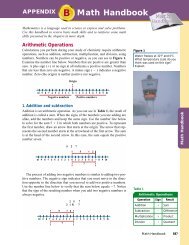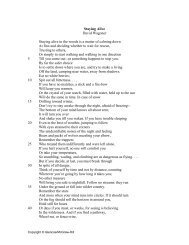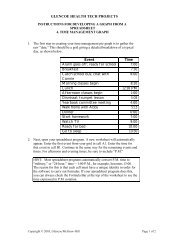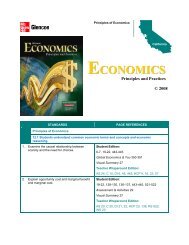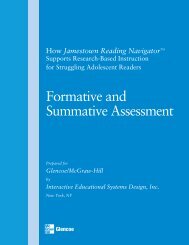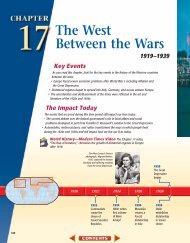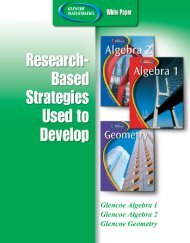Vocabulary - Research
Vocabulary - Research
Vocabulary - Research
Create successful ePaper yourself
Turn your PDF publications into a flip-book with our unique Google optimized e-Paper software.
ANALYSIS AND<br />
RESULTS<br />
Summary of <strong>Vocabulary</strong><br />
Recommendations<br />
Students’ vocabulary learning<br />
should be regularly assessed in<br />
multiple ways, including ways<br />
closely matched to the instructional<br />
context.<br />
Application Through<br />
Jamestown Reading Navigator<br />
Students’ vocabulary learning is assessed in several ways in Jamestown<br />
Reading Navigator, which match the ways that vocabulary is taught in the<br />
program. These include<br />
• Quick Match drag-and-drop activities, which test a variety of word features<br />
including definitions, synonyms, antonyms, and characteristics<br />
• Yes/no questions<br />
• Embedded multiple choice comprehension questions in the Journey Tests<br />
and Quest Tests<br />
• Cloze statements where a student is asked to complete a series of sentences<br />
by inserting one selection vocabulary word into a blank space in a statement<br />
Preteaching critical vocabulary can<br />
help students understand instructional<br />
text passages.<br />
Jamestown Reading Navigator preteaches critical vocabulary from text selections<br />
before students encounter the vocabulary in their reading.<br />
Students should either be taught<br />
new words in context or reminded<br />
of word meanings when they<br />
encounter them in context.<br />
Within the text selections in Jamestown Reading Navigator, the vocabulary<br />
words are hyperlinked to the word cards students have already viewed, so<br />
that students are provided with the definition, sample sentence, and characteristics<br />
of the word at the point of use.<br />
Student-friendly explanations<br />
should be provided for new vocabulary<br />
words.<br />
Explanations of new words in Jamestown Reading Navigator are student<br />
friendly.<br />
• The word cards use everyday-language definitions and sample sentences<br />
that characterize the word and explain how it is typically used.<br />
• The Look Back at <strong>Vocabulary</strong> animations for reteaching vocabulary if<br />
needed are student friendly and often humorous.<br />
• Additionally, the online dictionary provides student-friendly definitions for<br />
many words that are not targeted vocabulary words.<br />
Instructional contexts should<br />
be provided for new vocabulary<br />
words.<br />
Most of the sample sentences on the word cards constitute instructional<br />
contexts that make it easy for students to deduce the word meaning: e.g., “A<br />
bionic leg takes the place of a real leg.”<br />
J a m e s t o w n R e a d i n g N a v i g a t o r<br />
Semantic mapping can help students<br />
develop in-depth knowledge<br />
of vocabulary words.<br />
One of the common prereading vocabulary activities in Jamestown Reading<br />
Navigator is having students use semantic mapping to complete a word web.<br />
In this activity, students are given a topic and a list of words that are used<br />
in the selection, which may include a combination of vocabulary words and<br />
other words that are probably already familiar to students. Students must<br />
categorize the words by topic. The word web helps students explore meanings,<br />
associations, and relationships about a concept or a topic related to the<br />
selection. While this activity is designed primarily as a prereading comprehension<br />
exercise, it can also help students develop more in-depth knowledge<br />
of targeted vocabulary words and other words they will encounter in the<br />
journey text selection.<br />
18<br />
Continued 2




